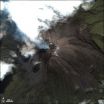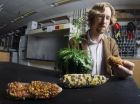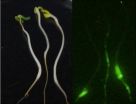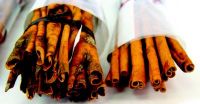(Press-News.org) Scientists have long known that large volcanic explosions can affect the weather by spewing particles that block solar energy and cool the air. Some suspect that extended "volcanic winters" from gigantic blowups helped kill off dinosaurs and Neanderthals. In the summer following Indonesia's 1815 Tambora eruption, frost wrecked crops as far off as New England, and the 1991 blowout of the Philippines' Mount Pinatubo lowered average global temperatures by 0.7 degrees F—enough to mask the effects of manmade greenhouse gases for a year or so.
Now, scientists have shown that eruptions also affect rainfall over the Asian monsoon region, where seasonal storms water crops for nearly half of earth's population. Tree-ring researchers at Columbia University's Lamont-Doherty Earth Observatory showed that big eruptions tend to dry up much of central Asia, but bring more rain to southeast Asian countries including Vietnam, Laos, Cambodia, Thailand and Myanmar—the opposite of what many climate models predict. Their paper appears in an advance online version of the journal Geophysical Research Letters.
The growth rings of some tree species can be correlated with rainfall, and the observatory's Tree Ring Lab used rings from some 300 sites across Asia to measure the effects of 54 eruptions going back about 800 years. The data came from Lamont's new 1,000-year tree-ring atlas of Asian weather, which has already produced evidence of long, devastating droughts; the researchers also have done a prior study of volcanic cooling in the tropics. "We might think of the study of the solid earth and the atmosphere as two different things, but really everything in the system is interconnected," said Kevin Anchukaitis, the study's lead author. "Volcanoes can be important players in climate over time."
Large explosive eruptions send up sulfur compounds that turn into tiny sulfate particles high into the atmosphere, where they deflect solar radiation. Resulting cooling on earth's surface can last for months or years. (Not all eruptions will do it; for instance, the continuing eruption of Indonesia's Merapi this fall has killed dozens, but this latest episode is probably not big enough by itself to effect large-scale weather changes.) As for rainfall, in the simplest models, lowered temperatures decrease evaporation of water from the surface into the air; and less water vapor translates to less rain. But matters are greatly complicated by atmospheric circulation patterns, cyclic changes in temperatures over the oceans, and the shapes of land masses. Up to now, most climate models incorporating known forces such as changes in the sun and atmosphere have predicted that volcanic explosions would disrupt the monsoon by bringing less rain to southeast Asia--but the researchers found the opposite.
The researchers studied eruptions including one in 1258 from an unknown tropical site, thought to be the largest of the last millennium; the 1600-1601 eruption of Peru's Huaynaputina; Tambora in 1815; the 1883 explosion of Indonesia's Krakatau; Mexico's El Chichón, in 1982; and Pinatubo. The tree rings showed that huge swaths of southern China, Mongolia and surrounding areas consistently dried up in the year or two following big events, while mainland southeast Asia got increased rain. The researchers say there are many possible factors involved, and it would speculative at this point to say exactly why it works this way.
"The data only recently became available to test the models," said Rosanne D'Arrigo, one of the study's coauthors. "Now, it's obvious there's a lot of work to be done to understand how all these different forces interact." For instance, in some episodes pinpointed by the study, it appears that strong cycles of the El Niño-Southern Oscillation, which drives temperatures over the Pacific and Indian oceans and is thought to strongly affect the Asian monsoon, might have counteracted eruptions, lessening their drying or moistening effects. But it could work the other way, too, said Anchukaitis; if atmospheric dynamics and volcanic eruptions come together with the right timing, they could reinforce one another, with drastic results. "Then you get flooding or drought, and neither flooding nor drought is good for the people living in those regions," he said. The study also raises questions whether proposed "geoengineering" schemes to counteract manmade climate change with huge artificial releases of volcanism-like particles might have complex unintended consequences.
Ultimately, said Anchukaitis, such studies should help scientists refine models of how natural and manmade forces might act together to in the future to shift weather patterns—a vital question for all areas of the world.
INFORMATION:
'The Influence of Volcanic Eruptions on the Climate of the Asian Monsoon Region' is at: http://www.agu.org/journals/pip/gl/2010GL044843-pip.pdf
View a slide show: Tree Rings, Climate Change and the Rainy Season
http://www.ldeo.columbia.edu/video/the-tree-ring-project
Author contacts:
Kevin Anchukaitis kja@ldeo.columbia.edu 845-365-8783
Rosanne D'Arrigo rdd@ldeo.columbia.edu 845-365-8617
Brendan Buckley bmb@ldeo.columbia.edu 845-365-8782
Edward Cook drdendro@ldeo.columbia.edu 845-365-8618
More information: Kevin Krajick, Senior Science Writer, The Earth Institute
kkrajick@ei.columbia.edu 212-854-9729
The Earth Institute, Columbia University mobilizes the sciences, education and public policy to achieve a sustainable earth. Through interdisciplinary research among more than 500 scientists in diverse fields, the Institute is adding to the knowledge necessary for addressing the challenges of the 21st century and beyond. With over two dozen associated degree curricula and a vibrant fellowship program, the Earth Institute is educating new leaders to become professionals and scholars in the growing field of sustainable development. We work alongside governments, businesses, nonprofit organizations and individuals to devise innovative strategies to protect the future of our planet. www.earth.columbia.edu
Lamont-Doherty Earth Observatory, a member of The Earth Institute, is one of the world's leading research centers seeking fundamental knowledge about the origin, evolution and future of the natural world. More than 300 research scientists study the planet from its deepest interior to the outer reaches of its atmosphere, on every continent and in every ocean. From global climate change to earthquakes, volcanoes, nonrenewable resources, environmental hazards and beyond, Observatory scientists provide a rational basis for the difficult choices facing humankind in the planet's stewardship. www.ldeo.columbia.edu
Volcanoes have shifted Asian rainfall
Defying models, some regions drier, others wetter
2010-11-04
ELSE PRESS RELEASES FROM THIS DATE:
Headgear, mouth guards have little or no impact on reducing concussions in rugby players
2010-11-04
TORONTO, Ont., Nov. 3, 2010 – Existing headgear and mouth guards have limited or no benefit in reducing concussions in rugby players, according to Dr. Michael Cusimano, a neurosurgeon at St. Michael's Hospital.
However, educational injury prevention programs that promote proper playing techniques and enforcement of the rules do result in a significant reduction in concussions and head, neck and spinal injuries, Cusimano concluded after a review of existing studies on the topic.
Cusimano still recommends rugby players wear mouth guards and protective headgear ...
Chromosome imbalances lead to predictable plant defects
2010-11-04
WEST LAFAYETTE, Ind. - Physical defects in plants can be predicted based on chromosome imbalances, a finding that may shed light on how the addition or deletion of genes and the organization of the genome affects organisms, according to a study involving a Purdue University researcher.
The findings identify easily measured characteristics that vary with imbalances of specific chromosomes, said Brian Dilkes, a Purdue assistant professor of horticulture. Understanding why and how those imbalances result in certain characteristics could open the door to correcting those ...
E. coli thrives near plant roots, can contaminate young produce crops
2010-11-04
WEST LAFAYETTE, Ind. - E. coli can live for weeks around the roots of produce plants and transfer to the edible portions, but the threat can be minimized if growers don't harvest too soon, a Purdue University study shows.
Purdue scientists added E. coli to soil through manure application and water treated with manure and showed that the bacteria can survive and are active in the rhizosphere, or the area around the plant roots, of lettuce and radishes. E. coli eventually gets onto the aboveground surfaces of the plants, where it can live for several weeks. Activity in ...
U of M researcher finds public support for HPV vaccine wanes when linked to controversy
2010-11-04
MINNEAPOLIS / ST. PAUL, Minn. (Nov. 2, 2010) – The vaccine that protects against the potentially cancer-causing human papillomavirus (HPV) enjoys wide support in the medical and public health communities. Yet state laws to require young girls to be vaccinated as a requirement for middle school attendance have aroused controversy with parents, politicians, and even medical and public health experts disagreeing about whether such laws are appropriate. News coverage about HPV vaccine requirements tends to amplify this controversy, possibly leading to negative attitudes among ...
Organic onions, carrots and potatoes do not have higher levels of healthful antioxidants
2010-11-04
With the demand for organically produced food increasing, scientists are reporting new evidence that organically grown onions, carrots, and potatoes generally do not have higher levels of healthful antioxidants and related substances than vegetables grown with traditional fertilizers and pesticides. Their study appears in ACS' bi-weekly Journal of Agricultural and Food Chemistry.
In the study, Pia Knuthsen and colleagues point out that there are many reasons to pay a premium for organic food products. The most important reasons for the popularity of organic food products ...
Built-in timer for improving accuracy of cost saving paper-strip medical tests
2010-11-04
Scientists are reporting the development of a simple, built-in timer intended to improve the accuracy of paper tests and test strips for diagnosing diseases inexpensively at-home and elsewhere. Their study appears in ACS' semi-monthly journal Analytical Chemistry.
Scott Phillips and Hyeran Noh note that so-called point-of-care tests include paper strip tests and others performed at home or bedside instead of in laboratories. They show special promise for improving medical care in developing countries and reducing health care costs elsewhere. When fully developed, these ...
Does adolescent stress lead to mood disorders in adulthood?
2010-11-04
Montreal, November 3, 2010 – Stress may be more hazardous to our mental health than previously believed, according to new research from Concordia University. A series of studies from the institution have found there may be a link between the recent rise in depression rates and the increase of daily stress.
"Major depression has become one of the most pressing health issues in both developing and developed countries," says principal researcher Mark Ellenbogen, a professor at the Concordia Centre for Research in Human Development and a Canada Research Chair in Developmental ...
Electrons get confused
2010-11-04
Scientists from Helmholtz-Zentrum Berlin (HZB) observed exotic behaviour from beryllium oxide (BeO) when they bombarded it with high-speed heavy ions: After being shot in this way, the electrons in the BeO appeared "confused", and seemed to completely forget the material properties of their environment. The researchers' measurements show changes in the electronic structure that can be explained by extremely rapid melting around the firing line of the heavy ions. If this interpretation is correct, then this would have to be the fastest melting ever observed. The researchers ...
Levels of coumarin in cassia cinnamon vary greatly even in bark from the same tree
2010-11-04
A "huge" variation exists in the amounts of coumarin in bark samples of cassia cinnamon from trees growing in Indonesia, scientists are reporting in a new study. That natural ingredient in the spice may carry a theoretical risk of causing liver damage in a small number of sensitive people who consume large amounts of cinnamon. The report appears in ACS' bi-weekly Journal of Agricultural and Food Chemistry.
Friederike Woehrlin and colleagues note that cinnamon is the second most popular spice, next to black pepper, in the United States and Europe. Cinnamon, which comes ...
Small materials poised for big impact in construction
2010-11-04
Bricks, blocks, and steel I-beams — step aside. A new genre of construction materials, made from stuff barely 1/50,000th the width of a human hair, is about to debut in the building of homes, offices, bridges, and other structures. And a new report is highlighting both the potential benefits of these nanomaterials in improving construction materials and the need for guidelines to regulate their use and disposal. The report appears in the monthly journal ACS Nano.
Pedro Alvarez and colleagues note that nanomaterials likely will have a greater impact on the construction ...
LAST 30 PRESS RELEASES:
The Ceramic Society of Japan’s Oxoate Ceramics Research Association launches new international book project
Heart-brain connection: international study reveals the role of the vagus nerve in keeping the heart young
Researchers identify Rb1 as a predictive biomarker for a new therapeutic strategy in some breast cancers
Survey reveals ethical gaps slowing AI adoption in pediatric surgery
Stimulant ADHD medications work differently than thought
AI overestimates how smart people are, according to HSE economists
HSE researchers create genome-wide map of quadruplexes
Scientists boost cell "powerhouses" to burn more calories
Automatic label checking: The missing step in making reliable medical AI
Low daily alcohol intake linked to 50% heightened mouth cancer risk in India
American Meteorological Society announces Rick Spinrad as 2026 President-Elect
Biomass-based carbon capture spotlighted in newly released global climate webinar recording
Illuminating invisible nano pollutants: advanced bioimaging tracks the full journey of emerging nanoscale contaminants in living systems
How does age affect recovery from spinal cord injury?
Novel AI tool offers prognosis for patients with head and neck cancer
Fathers’ microplastic exposure tied to their children’s metabolic problems
Research validates laboratory model for studying high-grade serous ovarian cancer
SIR 2026 delivers transformative breakthroughs in minimally invasive medicine to improve patient care
Stem Cell Reports most downloaded papers of 2025 highlight the breadth and impact of stem cell research
Oxford-led study estimates NHS spends around 3% of its primary and secondary care budget on the health impacts of heat and cold in England
A researcher’s long quest leads to a smart composite breakthrough
Urban wild bees act as “microbial sensors” of city health.
New study finds where you live affects recovery after a hip fracture
Forecasting the impact of fully automated vehicle adoption on US road traffic injuries
Alcohol-related hospitalizations from 2016 to 2022
Semaglutide and hospitalizations in patients with obesity and established cardiovascular disease
Researchers ‘listen in’ to embryo-mother interactions during implantation using a culture system replicating the womb lining
How changing your diet could help save the world
How to make AI truly scalable and reliable for real-time traffic assignment?
Beyond fragmented markets: A new framework for efficient and stable ride-pooling
[Press-News.org] Volcanoes have shifted Asian rainfallDefying models, some regions drier, others wetter






